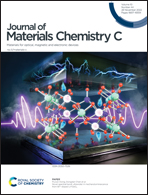The effect of slurry pH on the chemical mechanical planarization of a carbon-doped Ge2Sb2Te5 phase change material†
Abstract
Chemical mechanical planarization (CMP) is receiving a growing interest in the fabrication of phase change memory in order to achieve a highly scaled confined cell structure and global planarization within wafers of up to 12 inches in diameter. In this work the H2O2 containing slurry with colloidal silica abrasive was investigated in the CMP of a carbon-doped Ge2Sb2Te5 (C-GST) film at various pH levels. In a slurry of pH 2, Ge and Sb were oxidized while Te remained unchanged. Under alkaline conditions, the dissolution effect of the slurry on the oxide layer enhanced, leading to the mechanical polishing mechanism. In a slurry of pH 5, the lowest surface roughness (0.517 nm) was achieved. Electrochemical impedance spectroscopy analysis indicated that the pH level of slurry affects the equilibrium of passivation and corrosion reaction on the surface of the C-GST film. The ndl in equivalent element circuits is related to the surface roughness of the film. This work shows an insight into the chemical effects of slurry pH in the CMP process of phase change materials through electrochemical means, which will benefit the development of a niche slurry for the integration of high density phase change memory devices.



 Please wait while we load your content...
Please wait while we load your content...